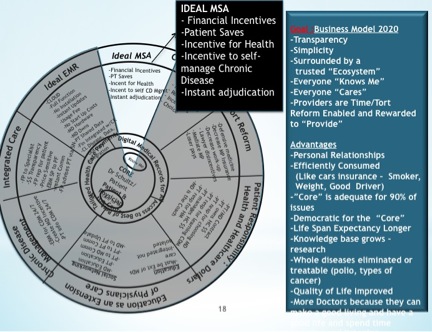A Real Marketplace For Healthcare.
Stanley Feld M.D.,FACP,MACE
President Obama’s Healthcare Reform Act is all about government control of 19% of the U.S. economy.
The media has publicized ridiculously high charges for cardiac bypass and other complicated procedures. It ought to find out what the actual contracted reimbursement fee is.
All the stakeholders are at fault for the lack of transparency, misinformation, administrative waste, misuse of taxpayers’ dollars and the manipulation of the media.
It is important for the government and the healthcare industry to continue to blame physicians for being the villain in our dysfunctional healthcare system.
Remember physician receive only 10% of the healthcare dollars spent in our healthcare system. Who receives the other 90%? What value do the other recipient add to medical care?
The medias quoted prices are a scare tactic to keep government’s control of the healthcare system advancing.
What is going to happen after Obamacare is repealed?
There will still be millions uninsured.
There will still be millions who cannot buy insurance because of pre-existing conditions.
There will still be millions who choose not to purchase coverage.
There will still be inefficiency and waste in the healthcare system.
Stakeholders are adjusting to the potential restrictions of Obamacare. They are finding new ways to game the healthcare system.
Healthcare costs will rise and inefficiency in the healthcare system will increase whether we have Obamacare or not.
President Obama is trying to set rules and create regulations to eliminate potential solutions to our healthcare system’s problems.
He is trying to regulate and eliminate high deductible insurance plans and Health Savings Accounts. Under Obamacare it will be much cheaper for employers to pay the penalty than provide healthcare insurance for their employees.
Employees will be forced to buy insurance from President Obama’s health insurance exchange (Public Option). There will be no other options. At that point the government has full control of healthcare.
It wouldn’t be a bad thing if the government could afford another potentially inefficient entitlement program. President Obama is clearly trying to squeeze complete government control of healthcare through the back door.
It will not work!
What should be done?
The government must create a real marketplace for healthcare insurance. A marketplace constructed for the benefit of consumers and not secondary stakeholders’ vested interests. Stakeholders would adjust because of their competitive compulsion to get customers. They will compete for consumer business by lowering healthcare costs.
The mindset must change to a consumer driven system not a government driven system.
My Ideal Medical Saving Account would be an excellent way to provide full first dollar healthcare insurance coverage for unplanned medical expenses. It would also provide financial incentive for consumers to be responsible for their health and healthcare dollars.
These are some of the rules that government should have.
1. Healthcare insurance policies should be “guaranteed renewable.”
2. Healthcare policies should include a right to purchase insurance in the future regardless of pre-existing illness.
3. Healthcare insurance policies should follow you from job to job regardless of a move across state lines.
4. Individual healthcare insurance policies should have the same tax-deductible status as employer provided healthcare insurance policies.
The government could form a successful individual insurance market place with these simple rules or regulations.
“Most pathologies in the current system are creatures of previous laws and regulations.”
“ Solicitor General Donald Verrilli explained as much in his opening statement to the Supreme Court: “The individual market does not provide affordable health insurance,” he noted, “because the multibillion dollar subsidies that are available” for the “employer market are not available in the individual market.”
My Ideal Medical Savings Account could apply to Medicare and Medicaid. It provides incentives and real healthcare insurance coverage. It allows the consumer to choose. It encourages consumers to be knowledgeable shoppers for healthcare.
The main argument for a mandate before the Supreme Court was that people of modest means can fail to buy insurance, and then rely on charity care in emergency rooms, shifting the cost to the rest of us.
The government is spending that money already. The mandate will not stop the emergency room use.
A consumer driven healthcare system using My Ideal Medical Saving Accounts would provide incentives for the indigent or those of modest means to try to save money for them by taking care of their health. The government provides those educational resources already. This might encourage its use.
The emergency room treatment expenses for indigent and uninsured are not the central reason for rising healthcare costs. Costs are rising because people, who do have insurance, and their doctors, overuse health services and don’t shop on price.
The Ideal Medical Savings Accounts should be fully tax deductible to both individual and groups. The healthcare system would then become consumer driven. Consumers would become price sensitive because of financial incentives. A competitive healthcare market would then be created. The result would be a decrease in the cost of healthcare. It certainly would be cheaper than the artificial, bizarre, government controlled healthcare market for we have today.
Enlarging government control would make the healthcare market more expensive and less efficient than the unsustainable government controlled healthcare system that exists.
The opinions expressed in the blog “Repairing The Healthcare System” are, mine and mine alone
Please have a friend subscribe


What i do not understood is in truth how you are no longer actually a lot more neatly-preferred than you may be now. You’re so intelligent. You recognize thus significantly in relation to this subject, made me for my part believe it from a lot of various angles. Its like men and women are not fascinated unless it is one thing to do with Girl gaga! Your own stuffs nice. Always take care of it up!